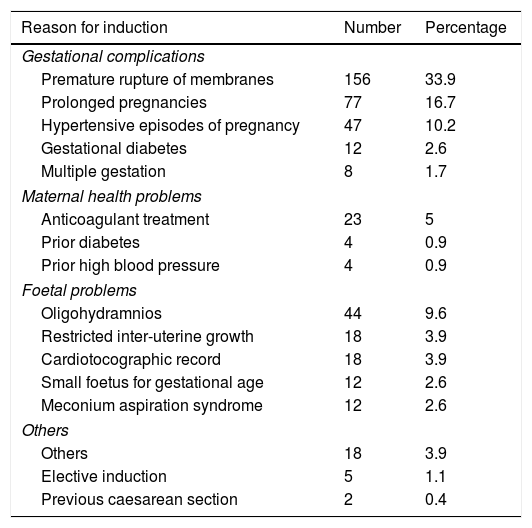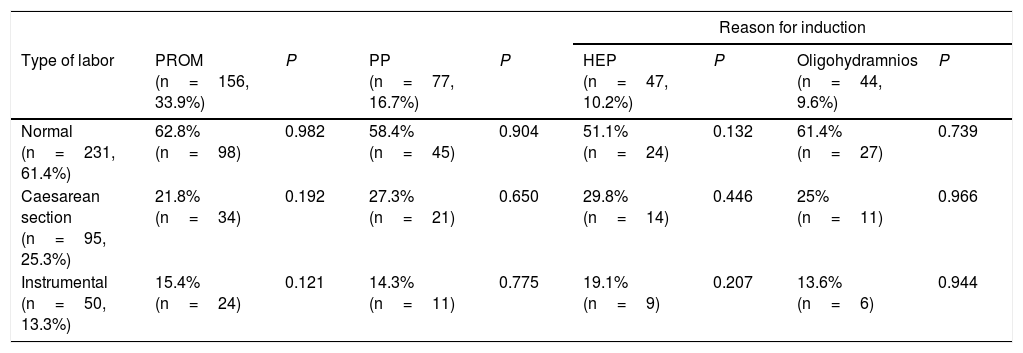Induction of labor (IOL) is a common obstetric practice which has increased in recent decades. The main objective of this study is to describe the characteristics of induced labor at Marqués de Valdecilla University Hospital.
MethodA descriptive, retrospective study was performed between January 1st and April 30th of 2014, by reviewing medical histories. A standardised registration has been used to collect data.
ResultsThere were a total of 376 IOL, the incidence was 35.1%. The most frequent indications were premature rupture of membranes (33.9%) and gestational age of 41 completed weeks or more (16.7%). Oxytocin was used to start 66.8% of the IOL. Of all births, 61.4% were spontaneous vaginal births and 25.3% caesarean sections. An increase in the rate of caesarean sections was observed in the group of gestational age of 41 completed weeks or more (27.3%) and hypertensive disorders of pregnancy (29.8%). The main cause of dystocia was suspected foetal compromise (36.4%). Adaptation to extrauterine life was within the parameters of normality in 94% of the newborn infants.
ConclusionsComparing the IOL with spontaneous labor, a decrease in spontaneous vaginal births and an increase in caesarean sections and operative vaginal births was observed in the inductions. This study provides relevant information to the professionals in the fields of gynaecology and obstetrics, and opens the way for future research to obtain results transferable to the clinical practice.
La inducción del parto (IDP) es una práctica obstétrica frecuente que se ha incrementado en las últimas décadas. El objetivo principal de este estudio es describir las características de los partos inducidos en el Hospital Universitario Marqués de Valdecilla.
MétodoDiseño descriptivo retrospectivo de los partos inducidos entre el 1 de enero y el 30 de abril de 2014 mediante la revisión de historias clínicas. La recogida de datos se ha realizado mediante un registro estandarizado.
ResultadosLa muestra fue de 376 IDP, siendo la incidencia del 35,1%. Las indicaciones más frecuentes fueron la rotura prematura de membranas (33,9%) y el embarazo en vías de prolongación (16,7%). El 66,8% de las IDP se iniciaron con oxitocina. El 61,4% de los partos fueron eutócicos y el 25,23%, cesáreas. Se observó un aumento del porcentaje de cesáreas en los grupos de embarazo en vías de prolongación (27,3%) y estados hipertensivos del embarazo (29,8%). La principal causa de distocia fue el riesgo de pérdida de bienestar fetal (36,4%). El 94% de los neonatos tuvieron una adaptación a la vida extrauterina dentro de los parámetros de normalidad.
ConclusionesComparando las IDP con los partos espontáneos, se observó que en las primeras los partos eutócicos disminuyen y aumentan las cesáreas y los partos instrumentales. Se aporta información de interés a los profesionales del ámbito de la ginecología y la obstetricia, y se abre camino a futuras investigaciones para obtener resultados transferibles a la práctica clínica.












